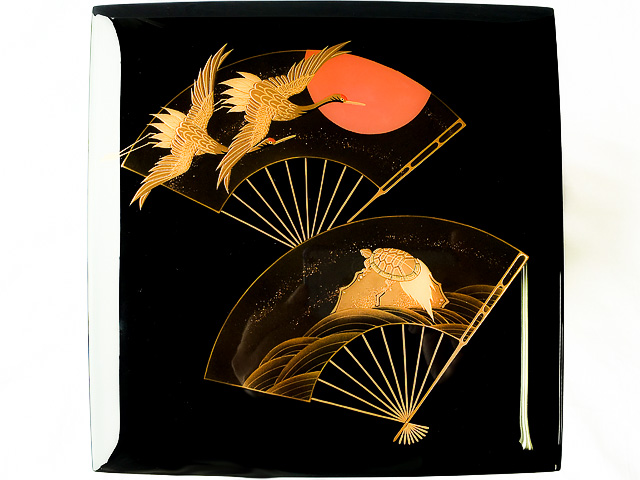輪島塗
海外で「japan」と呼ばれる日本の漆器。
「素地が木地であること」「布着せしていること」「地の粉下地であること」
この3つの条件を満たして輪島で制作される漆器が輪島塗と呼ばれ重要無形文化財に指定されているのが伝統工芸輪島塗です。
堅牢優美な輪島塗は傷んでも直すことができ、世代を越えてお使い頂ける漆器です。

Wajimanuri
Japanese lacquerware is called “japan” overseas.
“The lacquer ware produced in Wajima is called “Wajima-nuri” because it meets the following three requirements: the base must be wood, the base must be covered with cloth, and the base must be made of ground powder.
The lacquerware produced in Wajima that meets these three requirements is called Wajima-nuri.
The traditional craft of Wajima-nuri is designated as an Important Intangible Cultural Property.
Wajima-nuri is a traditional craft designated as an important intangible cultural property. The robust and elegant Wajima-nuri lacquerware can be repaired even if it is damaged and can be used for generations to come.
輪島塗の歴史
縄文時代前期(約5000年前)の頃から、漆器の伝統を脈々と受け継いできた場所
それが能登半島であり輪島塗だといわれています。
江戸時代中期から後期にかけて、堅牢な塗りを生かした華麗な沈金技法の採用などによって全国的に知られるようになり、近代になると蒔絵技法が導入され、塗り・加飾ともに輪島塗の名が全国に知れ渡るようになりました。
History
Since the early Jomon period (about 5,000 years ago), the tradition of lacquerware has been passed down from generation to generation.
It is said that this is the Noto Peninsula and Wajima lacquerware.
From the middle to the end of the Edo period, Wajima lacquerware became known throughout the country through the use of gorgeous chinkin techniques that took advantage of the robust lacquer.
In the modern era, the Maki-e technique was introduced, and Wajima-nuri became known throughout Japan for both its lacquering and decoration.
Translated with www.DeepL.com/Translator (free version)
輪島塗の特徴
輪島塗の特色はなんといっても堅牢な下地にあります。
下地は、木地のうえに地の粉と呼ばれる「珪藻土の焼成粉末」を漆に混ぜて塗る「本堅地の技法」で作り上げます。
微細な孔をもつ 珪藻殻の粒子に漆液がよくしみこみ、科学的にも安定した材質となることが確かめられています。
Characteristics
The distinctive feature of Wajima-nuri is its robust base.
The base is made by mixing “JINOKO,” a calcined diatomaceous earth powder, with lacquer and applying it to the wooden base.
It has been scientifically confirmed that the diatom shell particles, which have minute pores, soak up the lacquer solution well, making it a stable material.
輪島塗の技術・技法
※「伝統的工芸品産業の振興に関する法律」(伝産法)により、伝統的工芸品として輪島塗であるための要件
1. 下地塗りは、次の技術または技法によること。
(1) 木地に生漆を塗付した後「着せもの漆」を塗付した麻または寒冷紗を用いて「布着せ」をすること。
(2) 生漆に米のり及び「輪島地の粉」を混ぜ合わせたものを塗付しては研ぎをすることを繰り返すこと。
2.上塗りは、精製漆を用いて「花塗」または「ろいろ塗」をすること。
3.加飾をする場合は、沈金または蒔絵によること。
4.木地造りは、次のいずれかによること。
(1) 挽き物にあっては、ろくろ台及びろくろかんなを用いて形成すること。
(2) 板物または曲げ物にあっては、「こくそ漆」を用いて成形すること。
Technology and Techniques
The following are the requirements for Wajima-nuri as a traditional craft according to the “Law Concerning the Promotion of Traditional Craft Industries” (Denzan Law).
1.The base coat shall be applied by the following techniques or methods.
(1) After applying raw lacquer to the wood base, “NUNOKISE” shall be applied using linen or cold gauze coated with “KISEMON-URUSHI”.
(2) Repeatedly apply raw lacquer mixed with rice glue and WAJIMA-JINOKO, and then polish the surface.
2.The top coat should be “HANA-NURI” or “ROIRO-NURI” with refined Urushi.
3.Decorating should be done by CHIN-KIN or MAKI-E.
4. Wood base shall be made by either of the following methods.
(1) Grindings shall be formed using a turntable and a turner.
(2) Plates or bent pieces shall be formed by using Kokuso urushi.
輪島塗の原材料
※「伝統的工芸品産業の振興に関する法律」(伝産法)により、伝統的工芸品として輪島塗であるための要件
1.漆は天然漆とすること。
2.木地は、ヒバ ケヤキ カツラ もしくはホオノキ、またはこれらと同等の材質を有する用材とすること。
Raw materials
Requirements for Wajima-nuri as a traditional craft according to the “Law for the Promotion of Traditional Craft Industries” (Denzan Law)
1. Lacquer must be natural lacquer.
2. The wood base shall be made of cypress, zelkova, katsura, honoki, or other materials equivalent to these.
輪島塗の製造地域
※「伝統的工芸品産業の振興に関する法律」(伝産法)により、伝統的工芸品として輪島塗であるための要件
・石川県輪島市
Production area
Requirements for Wajima-nuri as a traditional craft according to the “Law for the Promotion of Traditional Craft Industries” (Denzan Law)
Wajima City, Ishikawa Prefecture
未来へと続く伝統
作家である故 前大峰氏(人間国宝)をはじめとして多数の著名人を輩出。
日展・伝統工芸展等の中央展常連作家は100余名を数えます。
A tradition that continues into the future
We have produced many famous artists, including the late Mae Omine, a living national treasure.
There are more than 100 artists who are regular exhibitors at the Nitten and the Traditional Craft Exhibition.
令和の輪島塗とは
輪島塗の “世界にひとつしかないものづくり” の伝統は現代にも受け継がれています。
特別な人物の調度品としてのお誂え需要から一般に広まりました。現代ではスタイリッシュで手に入りやすい商品に押されながらも憧れの漆器を身近に使いたいというニーズへ移り変わっています。古くからオーダーメイド漆器の産地であり、世界中の注文に応え時代にあう漆器を創り続けてきた輪島塗は、独特の塗りの厚さを感じる表面の艶やかさ、技巧を凝らした蒔絵や沈金の加飾の美しさで世界に感動をうんできました。想いのこもったオーダーメイド品であったので、その技術の高さとともに称賛され大切に扱われてきたのでしょう。
この時代に輪島塗がどうあるべきか、感染症や戦争、自然環境破壊の問題と世界規模の問題が山積みですが、長い歴史の中で繰り返されてきた様々な問題を乗り越えてきた技術と職人の気概を受け継いだものとして、現代に輪島塗があることの意味を考え模索しています。人生の節目にハレの器として用いられ、大切な行事の記念品として重用された輪島塗は、大切な人と過ごした時間や思い出とともにあることに精神的価値があり、日本文化を創造してきました。
令和の輪島塗のあり方が100年後の輪島塗を変える、次の時代へのバトンは令和の職人の手の中にあります。
縄文から令和へ1400年の歴史の先へも日本文化が継承されるよう、日本の美しい風景や宝物が受け継がれていくことを願って”昔ながら”を守り挑戦し続けます。祈りの器から発展した日本の漆は、令和の時代でもその精神を受け継ぎ未来へ届ける活動を続けています。
What is Reiwa’s Wajima-nuri?
The Wajima-nuri tradition of “one-of-a-kind manufacturing” is still carried on today.
Wajima-nuri spread to the general public because of the demand for custom-made products as furnishings for special people. Today, the demand has shifted to the everyday use of lacquerware, while being kept in fashionable and friendly products. Wajima-nuri has long been a production center for custom-made lacquerware, responding to orders from all over the world and meeting the needs of the times. Since Wajima-nuri is custom-made, there must have been a longing and attachment to it as well as a high level of skill.
In this day and age of global problems such as infectious diseases, wars, and destruction of the natural environment, Wajima-nuri continues to search for the ideal form of Wajima-nuri. Wajima-nuri has created Japanese culture with its spiritual value as a vessel to decorate life’s milestones and as a memento to remember loved ones.
The baton will be passed to the next generation in the hands of Reiwa’s craftsmen, and the way Wajima-nuri is made in Reiwa will change Wajima-nuri 100 years from now.
We will continue to challenge ourselves to preserve the “old-fashioned” way, hoping that the beautiful scenery and treasures of Japan will be handed down to the next generation and that the Japanese lacquer culture, which has continued since the Jomon period, will be handed down to the next generation. Japanese lacquerware has developed from prayer vessels, and we will continue to carry this spirit into the future.